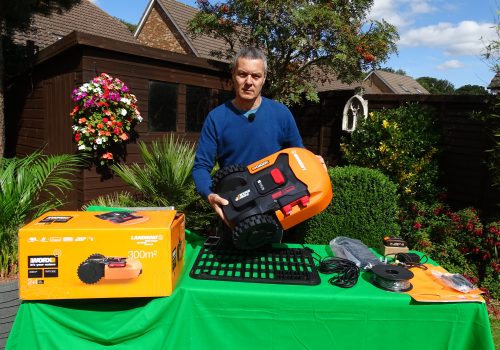
As an enthusiast of robotic mowers, I have encountered numerous advantages they possess. Yet, it is essential to be aware of some minor problems that can emerge despite manufacturers’ best efforts. While these issues may seem daunting initially, they certainly aren’t deal-breakers, as the solutions tend to be simple and efficient.
The reassuring part is that these minor problems do not overshadow the convenience and time-saving benefits of owning a robotic mower. Whether it’s a small garden or a large lawn, investing in a robotic lawnmower remains a smart choice. It is crucial, however, to learn more about these devices to pick the one that best suits your needs.
The Problems with Robotic Mowers at a Glance are:
- Cutting to the Edge: Robotic mowers often struggle to trim grass cleanly along the edges of the lawn, leaving uncut areas near borders.
- Setting Up: Installation of the perimeter wire can be complex and time-consuming, requiring precise placement to guide the mower properly.
- Sloped Lawns: Steep inclines can pose challenges for robotic mowers, leading to inefficient cutting patterns or the mower getting stuck.
- Multi-Zones: Managing multiple lawn areas can be difficult, as the mower must navigate between zones without guidance.
- Blade Maintenance: Regular blade sharpening or replacement is necessary to ensure a clean cut and prevent damage to the grass.
- Debris on the Lawn: Robotic mowers can be obstructed by twigs, toys, or other debris, causing them to miss spots or get stuck.
- Theft: Due to their high value and outdoor usage, robotic mowers can be an attractive target for theft.
- Safety Concerns: Accidental activation or malfunctions can pose safety risks to pets and children if not properly supervised.
- Weather Sensitivity: Robotic mowers may not function optimally in adverse weather conditions, such as heavy rain or extreme heat.
- Limited Battery Life: The battery life of a robotic mower can restrict the size of the lawn it can maintain in a single charge.
- Navigation Challenges: Some models may have difficulty navigating around obstacles or through narrow passages without human intervention.
Key Takeaways
- Robotic mowers have some minor issues, but they are generally simple and quick to resolve
- The time-saving and convenience benefits of a robotic mower outweigh these problems
- Selecting the perfect robotic lawn mower involves understanding these issues and finding the best fit for your garden by following tips from a helpful resource like How To Pick The Perfect Robot Lawn Mower.
Problems with Robotic Lawn Mowers
1. Cutting To The Edge
Robot mowers require a perimeter wire around the garden to know their boundaries. Exact measurements are given for where the wire should be laid. This is because the robotic mower needs space to turn once it reaches the boundary wire. In some areas like along the side of your house, the mower won’t be able to reach every single piece of grass. Some models, like the WORX robotic mowers, claim to cut right to the edge by offsetting the rotating blade to one side, but it’s still not 100% perfect.
2. Setting Up Your Robotic Mower
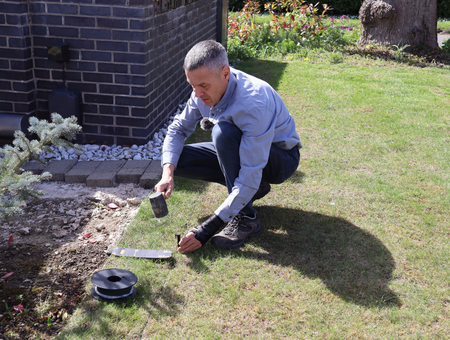
All robotic mowers need some installation and setting up, but it’s not too complicated. Basic DIY skills are enough to install and configure a robotic mower. Many models now have intuitive smartphone apps for easier configuration. You can also have your robotic mower professionally installed by a company if you prefer.
3. You Will Become A Robotic Mower Geek
You might find yourself becoming a robotic mower enthusiast, telling everyone about its benefits and performance. You may even consider designing and building a garage for your robotic mower.
You may even go as far as designing and building a garage for your robotic mower. A true robotic mower geek.
4. Sloped Lawns
Always consider the gradient of slope your robotic mower can navigate before purchasing. Some models have a better ability to deal with slopes than others. Mowing on wet grass or using a robot mower on sloped lawns can do more harm than good. Some robot mowers have rain sensors to avoid mowing in wet conditions, but others might need manual intervention during bad weather.
5. Multi-Zones
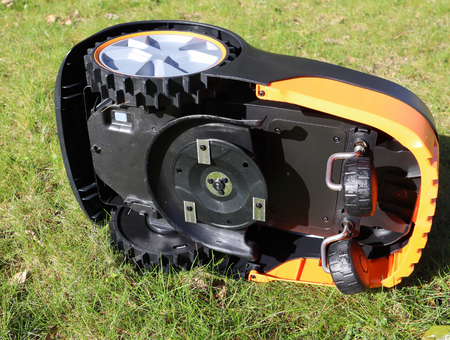
Modern robotic mowers can handle multiple zones, but they need to travel between zones. If there are obstacles like steps, fences, or gates, the robotic mower will not autonomously move from one zone to another. In such cases, you’ll need to manually move the mower between zones.
6. Robotic Mower Blade Maintenance
There are two types of blades fitted to modern robotic mowers: a single steel blade or multiple rotating razor blades. The latter can become blunt relatively quickly and need to be replaced every 3 to 4 months. However, they are easy and inexpensive to replace.
7. Debris On The Lawn
Debris like fallen fruit or pinecones could pose some difficulties for some robotic mowers. Choose a model that can handle the type of debris common on your lawn or be prepared to remove debris manually before the mower starts its work.
8. Now For A Slightly More Serious Problem

Breaks in the boundary wires can be a common issue, which can be frustrating to deal with. However, this problem can often be fixed by locating the source of the issue and repairing or replacing the damaged wire.
- When you first start using your robot lawn mower, make sure that you set it to an appropriate cutting height that won’t accidentally nick the wire. You won’t need to worry about this once the wire is properly embedded but for now, it’s essential.
- Moreover, when you are installing the boundary wire, take your time and make sure that there are no bits protruding that the robot mower could cut as it works.
- When you’re tightening the cable clamps, it is possible for you to hammer into the insulation around the wire. If this happens then moisture will be able to get in and this will eventually cause problems.
- After you have installed the wire, make sure that you make a note of its exact location. While it will embed, you don’t want to risk damaging it when you’re doing things like scarifying and having a diagram of where the wire is will help to prevent this.
Top Tip: When installing the boundary wire, be sure to leave several loops of wire on each side of the lawn. This will allow you to pull through a little extra wire if it get damaged or broken to re-join the two ends using the supplied connectors.
Alternatively, there are now boundary wire free robotic mowers that do NOT require a boundary wire to be installed around the lawn. See section below.
Boundary Free Wireless Robotic Mowers
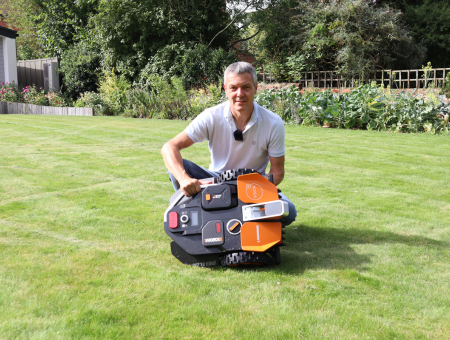
The very first robotic lawn mower, called the MowBot, was invented in 1969. Initially, the technology was not as sophisticated as we see today, and it wasn’t until the mid-90s that robot mowers became available to the public. The boundary wire has always been a crucial component of robotic mowers; however, recent advances in technology have introduced mowers that can navigate the garden without the need for a wire. As a result, I have put together valuable information on the latest technology, what to expect, and things to consider when buying a boundary free wireless robotic mower.
There are two innovative methods for helping robotic mowers operate without the need for boundary wires:
- Real Time Kinematics (RTK): Introduced in 2021, this GPS-based navigation system accurately maps your lawn. RTK mowers use a second GPS tracker in the base, which significantly improves their accuracy. A great example of this type of navigation can be seen on the LUBA AWD 5000 robotic mower.
- Visual/Camera Guidance: Companies like WORX, Toro, LawnMaster, and Segway have introduced visual or camera-guided systems that can detect objects and map the lawn. Great examples of a robotic mower that uses camera navigation is the WORX Vison M600 and the LawnMaster VBRM16.
While RTK generally offers a more efficient and reliable navigation system, vision-guided mowers are an excellent alternative for gardens with obstacles and lots of tree cover.
Best New Models and Their Features
As this technology is still relatively new, there are only a few robotic mowers with either RTK or camera systems available. Some notable options include:
- LUBA AWD 5000: An RTK system model that features slopes up to 75%, 5000 square metre coverage, suspension arms, in wheel motors, easy app control, three sets of blades included, all wheel drive, theft protection, up to 10 mowing zones, and all-weather use.
- Lawnmaster VBRM16: A more affordable camera-guided mower. Although not as feature-rich as the LUBA AWD 5000, it still offers excellent performance.
- WORX Landroid Vision M600: The WORX Landroid Vision Robotic Mowers are an innovative and high-tech solution for lawn maintenance. These robotic mowers require no boundary wire and are equipped with advanced features such as artificial intelligence, object detection, and mapping technology, allowing them to navigate and mow your lawn with precision and efficiency.
In conclusion, while boundary wire technology still has its place, boundary-free wireless robotic mowers offer a more advanced and convenient lawn mowing experience. Both RTK and camera guidance systems have their strengths, and your choice of mower largely depends on your garden’s needs and budget. Regardless of the system, robotic mowers are a great investment for an efficient and effortless lawn care experience
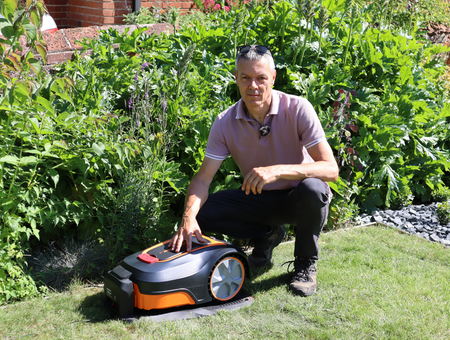
Are These Robotic Mower Problems Really That Big a Deal?
In my experience, the small problems associated with robotic mowers are manageable and shouldn’t deter you from enjoying their benefits. Whilst issues may arise, such as difficulty trimming edges, handling steep slopes, or the occasional error message, these can be addressed with proper maintenance, support, and following the advice provided.
Most robotic mowers come with lithium-ion batteries, offering reliable performance and easy storage. Timely notifications can help you keep tabs on your mower’s performance and address potential issues before they escalate.
By taking care of your robotic mower and applying the right tips, you can enhance its longevity and effectiveness. I believe the time-saving aspect and the freedom robotic mowers provide outweigh these minor setbacks. Moreover, fixing a problem or occasionally restarting the mower still beats the traditional method of sweating away under the hot sun.
Best Selling Robotic Mowers
Last update on 2024-04-04 / Affiliate links / Images from Amazon Product Advertising API
In my experience, quality robotic mowers come with extra features and specifications that improve their performance. One model that stands out is the Flymo EasiLife series, which offers excellent value for money. The latest iteration, the EasiLife Go 250 mower, simplifies the setup process while maintaining the series’ high standards.
Notable features of these mowers include remote control capabilities, making maintenance a breeze. When it comes to robotic lawn mowers for big gardens, options abound, and I’ve narrowed down the best available in the UK. Additionally, if you’re unsure about investing in a robotic mower, I’ve listed nine reasons to consider making the switch.
For more in-depth reviews of the best robotic lawn mowers in the UK 2023, make sure to explore the comprehensive information available, and feel free to reach out if you have any questions or need advice on choosing the perfect mower for your garden’s specific needs and requirements.
Frequently Asked Questions
How much energy do robotic mowers consume?
In general, robotic mowers consume significantly less energy compared to traditional petrol or electric lawn mowers. They typically operate on rechargeable batteries, and their energy consumption varies based on factors such as lawn size, terrain, and battery capacity. Some models may consume as little as 20 kWh per year on average.
Can robotic lawn mowers operate in rain?
Although many robotic lawn mowers are designed to be water-resistant, it's generally not recommended to operate them in heavy rain or extremely wet conditions. Prolonged exposure to water might damage the mower's electrical components. It is best to check the manufacturer's guidelines for specific details regarding the water resistance of your mower.
What are common issues with robotic mowers?
Navigating obstacles: Robotic mowers might have trouble navigating around obstacles or uneven terrain. Maintaining a clear lawn and considering the mower's specifications for handling obstacles can help avoid these issues. Boundary wire issues: Many mowers rely on a boundary wire to guide their movement. If this wire becomes damaged or misplaced, the mower may not function properly. Blade wear and tear: Just like traditional mowers, the blades on robotic mowers will eventually need replacement due to wear or damage. Regularly checking blade sharpness can help prolong their lifespan.
How long is the lifespan of a robotic mower?
The lifespan of a robotic mower can generally range from 5 to 10 years, depending on factors such as usage, maintenance, and quality of the mower itself. Proper care, following manufacturer guidelines, and timely replacement of worn components can help prolong the life of your mower.
Are refurbished robotic lawn mowers reliable?
Refurbished robotic lawn mowers can be a cost-effective option if you're looking for a lower-priced alternative. However, it's important to purchase these from reliable sources and verify that they have been thoroughly tested and refurbished to ensure their reliability and performance.
How do robotic mowers manage fallen leaves?
Robotic mowers are not specifically designed to manage leaf clean-up. While they might shred some leaves incidentally during the mowing process, their primary function is to maintain lawn grass. For efficient leaf management, it's best to consider dedicated leaf blowers or similar equipment.
As a seasoned expert in the field of garden power tools, I have dedicated over a decade to working with and reviewing a wide variety of lawn mowers. My extensive experience has allowed me to gain a deep understanding of the benefits and limitations of different types of mowers and garden tools.
Over the years, I have honed my skills in writing informative articles and creating helpful videos for various blogs and publications. This has given me the ability to not only recognise what makes a good lawn mower, but also to help you choose the perfect garden tool for your specific needs and requirements.
With my wealth of knowledge and expertise, I am confident that I can provide you with valuable insights and recommendations when it comes to selecting the right lawn mower for your lawn. So, whether you're looking for a battery cordless, electric, petrol, or robotic mower, you can trust in my expertise to guide you towards the best option for your garden.

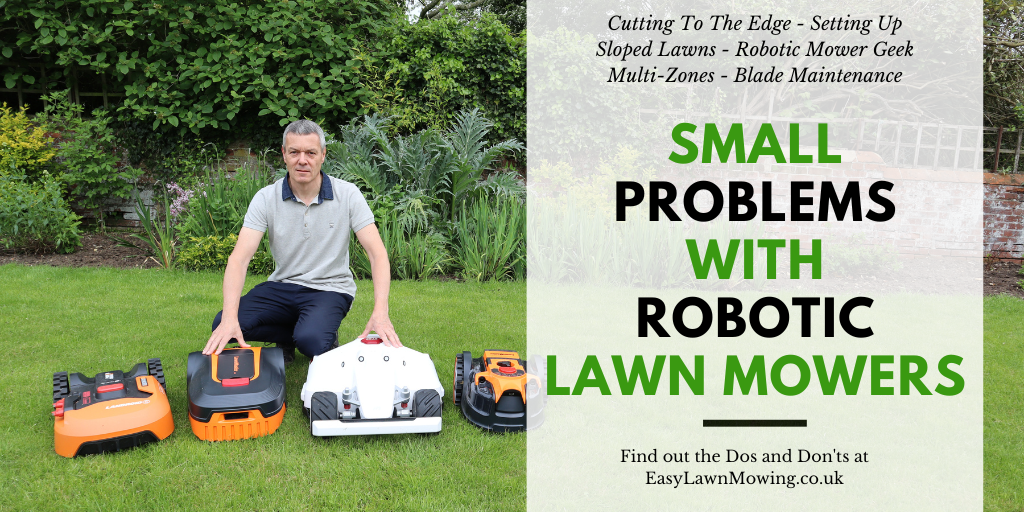
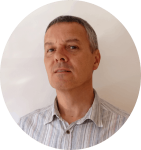









Need help.i hosed down my lawnmaster l10 a week ago and now it won’t cutt the grass it will follow buntry wire back to its garage .warning light flashing. I’m really hopeing this is a minor issue as I’ve got rather attached to this week mower it’s absolutely fantastic. Any advice would be gratefully appreciated.
Hi James
Please contact Cleva support to ask them about this. I would leave the mower turned off for a couple of days to dry out, then try again.
Could you please let us know if the mower recovers and what Cleva advise you to do?
Many thanks
Mark